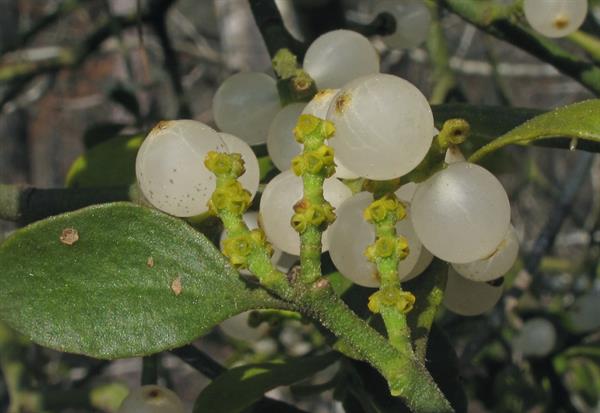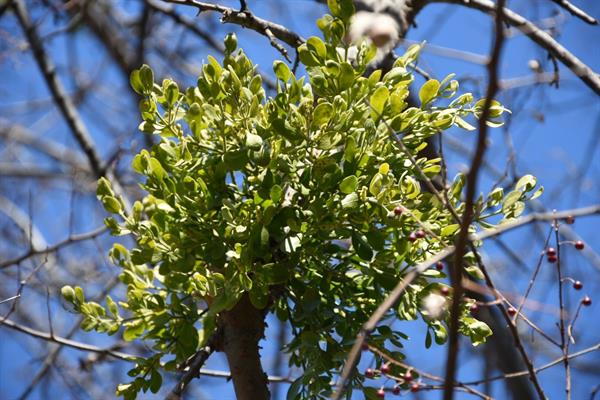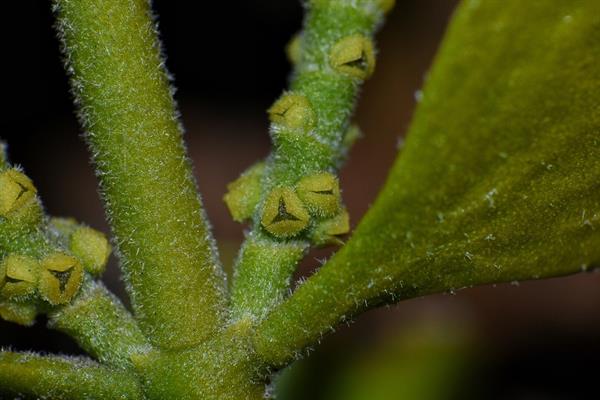
Origin/Endemic status: Native
Taxonomy Comments: Kuijt (2003) interprets this as a species with four subspecies; ssp. serotinum is the eastern component, ranging from NJ west to s. OH, s. IN, and s. MO, south to s. FL and s. TX. Hawkins (2010) studied the subspecies and population structure in P. leucarpum and found complex patterns of molecular and morphological variation that do not readily correspond to the subspecies. While the best taxonomic resolution is unclear, I here retain ssp. leucarpum for the easternmost element in this complex (the only element in our area). The other three subspecies of Kuijt (2003) are distributed in sw. United States and n. Mexico. The same four subspecies are recognized by Abbott & Thompson, under what has now been ruled to be the correct species name: P. leucarpum (Applequist 2012). The lengthy and arcane debates about the correct nomenclature are summarized by Abbott & Thompson (2011), and references cited therein.
Other Comments: Phoradendron is, of course, the mistletoe familiar (at least traditionally) in e. United States as a Christmas decoration. Kuijt (1982) comments that "the superficial likeness of Phoradendron serotinum to the European Viscum album has made the transfer of the latter's folklore to North America easy;" Viscum album was a sacred plant of Celtic and druidical pre-Christian European societies. The white berries of P. leucarpum are extremely poisonous. Their sticky flesh promotes the dispersal of the seeds by birds from tree to tree.
Synonymy: = K3, Va, Abbott & Thompson (2011); = Phoradendron leucarpum (Raf.) Reveal & M.C.Johnst. – K4; = Phoradendron serotinum (Raf.) M.C.Johnst. ssp. serotinum – Kuijt (2003); = Phoradendron tomentosum (DC.) Engelm. ex A.Gray ssp. tomentosum – Tx; > Phoradendron eatonii Trel. – S; < Phoradendron flavescens (Pursh) Nutt. – F, G, Tat, WV; > Phoradendron flavescens (Pursh) Nutt. – S; < Phoradendron leucarpum (Raf.) Reveal & M.C.Johnst. – Ar, Fl4, FNA12, Il, K1, NY, Pa, Tn, WH3; > Phoradendron macrotomum Trel. – S; < Phoradendron serotinum (Raf.) M.C.Johnst. – C, RAB, W, Kuijt (1982); > Phoradendron serotinum (Raf.) M.C.Johnst. – GrPl; > Phoradendron tomentosum (DC.) Engelm. ex A.Gray – GrPl, NcTx
Heliophily: 7
Hover over a shape, letter, icon, or arrow on the map for definition or see the legend.
 © Gary P. Fleming | Original Image ⭷
© Gary P. Fleming | Original Image ⭷ © Alan Cressler: Phoradendron leucarpum, fruit and flowers, River Bed Wildlife Management Area, Lower Tract, Laurens County, Georgia 1 by Alan Cressler source | Original Image ⭷
© Alan Cressler: Phoradendron leucarpum, fruit and flowers, River Bed Wildlife Management Area, Lower Tract, Laurens County, Georgia 1 by Alan Cressler source | Original Image ⭷ © Scott Ward | Original Image ⭷
© Scott Ward | Original Image ⭷ © Aidan Campos source | Original Image ⭷
© Aidan Campos source | Original Image ⭷ © Aidan Campos source | Original Image ⭷
© Aidan Campos source | Original Image ⭷ © Scott Ward | Original Image ⭷
© Scott Ward | Original Image ⭷ © Jeff Pippen | Original Image ⭷
© Jeff Pippen | Original Image ⭷ © Aidan Campos source | Original Image ⭷
© Aidan Campos source | Original Image ⭷ © Alan Cressler: phoradendron leucarpum, near the sopchoppy river, sopchoppy, wakulla county, florida 1 by Alan Cressler source | Original Image ⭷
© Alan Cressler: phoradendron leucarpum, near the sopchoppy river, sopchoppy, wakulla county, florida 1 by Alan Cressler source | Original Image ⭷ © Scott Ward, some rights reserved (CC BY), uploaded by Scott Ward source CC-BY | Original Image ⭷
© Scott Ward, some rights reserved (CC BY), uploaded by Scott Ward source CC-BY | Original Image ⭷Feedback
See something wrong or missing on about Phoradendron leucarpum ssp. leucarpum? Let us know here: (Please include your name and email if at all complicated so we can clarify if needed.)
Cite as...